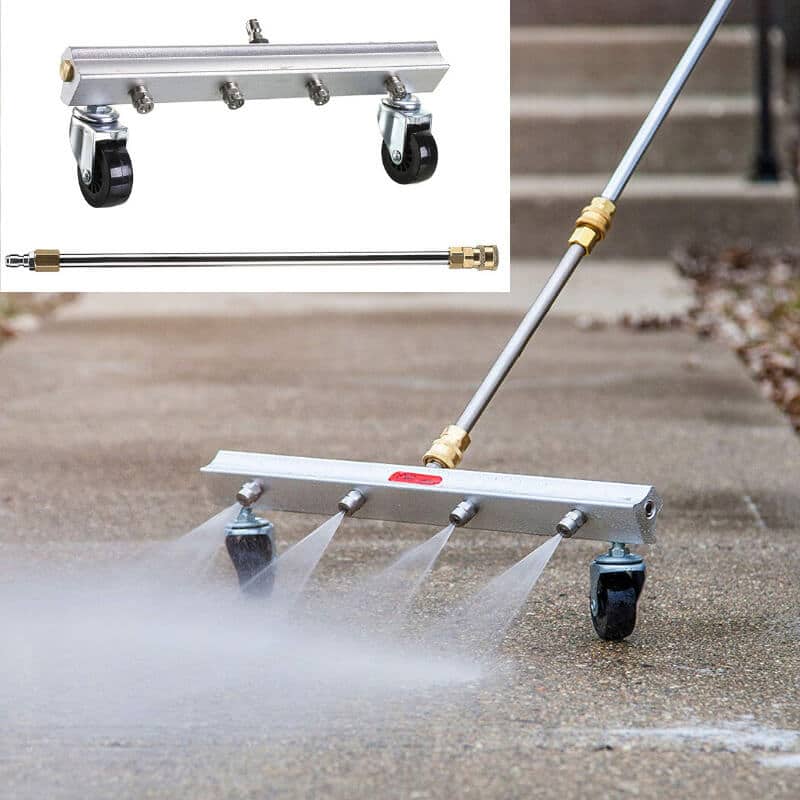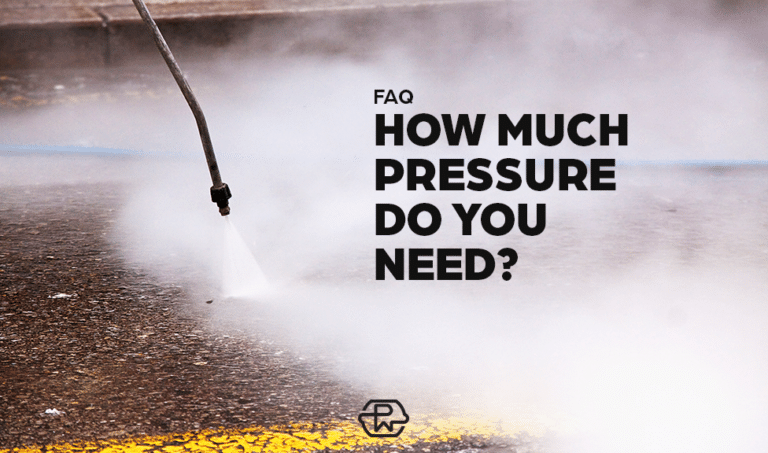Water Brooms Versus Surface Cleaners: Pros, Cons, and FAQs
There are many different options to choose from for pressure washing and power washing. You can use a water broom or a surface cleaner.
Both water brooms and surface cleaners are excellent choices for saving time and cleaning efficiently without using any harsh chemicals. They offer easy operability and shorter cleaning times.
So which is the right tool for the right job? In this blog post, we will discuss the pros and cons of each option and help you decide which is the best choice to add to your cleaning gear. We will also answer some frequently asked questions about water brooms and surface cleaners so that you can make an informed decision before purchasing one of these products!
What is a Water Broom?
A water broom is a cleaning tool that uses high-pressure water jets from nozzles in straight lines to clean surfaces. Water brooms have a long, cylindrical brush that spins around to sweep away dirt and debris. A common water broom rinses the surface as it cleans, so you don’t have to use a separate hose to rinse afterward.
Water brooms come in different sizes and lengths depending on how large a cleaning area you have.
They can be used on indoor and outdoor surfaces, such as carpets, floors, wooden decks, boat decks, and cars.
High-pressure washer brooms are great for quickly cleaning large surfaces without harsh chemicals. Power washer brooms work great on cars as an undercarriage cleaner. A common water broom
What is a Surface Cleaner?
A pressure washer surface cleaner has spinning nozzles that spray water in all directions at once and have several small brushes that rotate to clean the surface. Surface cleaners come in sizes that range from 18 inches to 36 inches, creating large spray widths.
A surface cleaner is better for larger areas, like a patio or deck. Pressure washer surface cleaners are also great for flat surfaces such as warehouse floors and patios.
Should you use a Pressure Washer or Power Washer?
Both use high-pressure water jets to clean surfaces, but the difference is how much force those jets have.
A power washer uses more force than a pressure washer, so it’s better for tougher stains like grease or dirt on concrete surfaces. If you’re looking to remove some light mud from your car, though – a pressure washer will do just fine!
An underbody pressure washer is perfect for cleaning cars and heavy equipment.
How do they attach to Pressure Washers or Power washers?
Water brooms and surface cleaners are an added attachment to pressure washers and power washers. They both use a snap coupler or quick-connect adapter that attaches to the spray gun on the pressure washer or power washer.
This allows the water broom or surface cleaner to be powered by the pressure washer or power washer, making it much more powerful than if a garden hose powered it.
A water broom attached to a pressure washer wand makes the job more efficient, and you’ll spend less time cleaning than with just a pressure washer wand alone.
Where can you buy these products?
Both products can be found at local home improvement stores or online retailers.
How much do they cost?
Water brooms typically cost between $25 and $100, while surface cleaners range from $40 to over $400. To determine which product is best for you, consider how often it will be used and what type of surfaces need cleaning to save money and make your purchase more cost-effective.
Now that we’ve covered the basics let’s take a closer look at the pros and cons of each type of cleaning tool.
Pressure Washer Water Broom vs. Surface Cleaner: Pros and Cons
Water Broom Pros:
- Use less water than surface cleaners, which is better for the environment. Energy savings are also a plus because they require less electricity to operate.
- Have a rubber flap that prevents water from spraying in all directions. Also, water brooms have adjustable jets that allow you to customize the pressure and direction of the water depending on what you are cleaning.
- Are more portable than surface cleaners because they’re smaller and lighter.
- Can be used on unlevel surfaces like decks and patios. Water brooms have a handle that allows use on uneven ground without tipping over or getting stuck in one spot.
- Nozzles don’t clog as easily as surface cleaner nozzles, which means they require less maintenance.
Water Broom Cons:
- Do not have wheels, so they cannot be moved as easily in small spaces.
- Can be difficult to operate on stairs.
Surface Cleaner Pros:
- Are easier to maneuver around tight corners or under furniture because they have wheels.
- Have a narrower nozzle which makes it easier to get into tight spaces.
- Come with a variety of attachments – like a brush, squeegee, or scrubber – for different types of surfaces.
- Are great for cleaning windows when they have a squeegee on the front of the cleaner.
Surface Cleaner Cons:
- Are not as good at covering a lot of ground in a short amount of time.
- Uneven spray marks are a common problem with surface cleaners. This is because the water jets are not evenly distributed.
- Nozzles can become clogged if you use the wrong detergent or if the water is too dirty.
Water Brooms vs. Surface Cleaners: FAQs
How much water do you need to use with a surface cleaner or water broom?
You should always follow the manufacturer’s instructions for your specific product. Still, in general, it is recommended that you use at least one gallon of water per minute when cleaning surfaces. Water flow can be adjusted to meet your needs.
What are the GPM requirements?
GPM, or gallons per minute, is the rate at which water flows from a faucet. Surface cleaning usually requires around 3.0 GPM which is on the higher end for many electric pressure washers and in the mid range for gas pressure washers. GPM requirements matter because it is a guide how much the motor can handle. You don’t want to have a smaller machine trying to clean with a larger (36in) cleaner. It can be done, but the engine will be overpowered.
How much pressure should you use?
Again, always follow the manufacturer’s instructions for your specific product. Follow the compatibility guidelines that your product specifies. The low pressure guideline for most models will be around 2000 PSI. Higher PSI/GPM for homeowners typically means a gas pressure washer over an electric one. It really comes down to how much work the motor can handle.
Can you use them on cars?
You can use either product to clean cars, but a water broom is better for this task because it has a longer brush that can reach the car’s bottom. A water broom also makes an excellent undercarriage cleaner. This is great for wet seasons when mud and dirt build up on your vehicle.
Can you use them on windows?
Neither product should be used on windows because they can break windows with their powerful jets of water.
Can you use them for concrete cleaning?
Both products work well for cleaning concrete, but we recommend that you use less pressure when using them on this type of surface as too much force could cause cracks in your driveway or patio!
Can you use them on car tires?
No, because they are not designed for this purpose and will cause damage to the tire treads if misused.
Can you use them on a roof?
Generally no. It’s not safe.
Can you use them on parking lots or for cleaning sidewalks?
Yes, both products can be used for cleaning sidewalks and parking lots. The road grime and oil stains on asphalt or concrete can be challenging to remove, but both of these products are up to the challenge!
Conclusion
So, what’s the verdict? In conclusion, both water brooms and surface cleaners have pros and cons. It is important to decide which one is right for you based on your specific needs. If you are looking for an easy way to clean large surfaces quickly and easily, a surface cleaner is the best option. However, if you are looking for an efficient way to clean small areas, a water broom is better. Thanks for reading!





![What’s the speed of the water coming out the nozzle of my pressure washer? [FAQ011]](https://pressurewashr.com/wp-content/uploads/2016/02/Water-Speed-Thumb-768x453.png)
![How Loud are Pressure Washers Compared to Other Home Goods? [FAQ16]](https://pressurewashr.com/wp-content/uploads/2017/10/How-Loud-Thumb-768x453.png)

